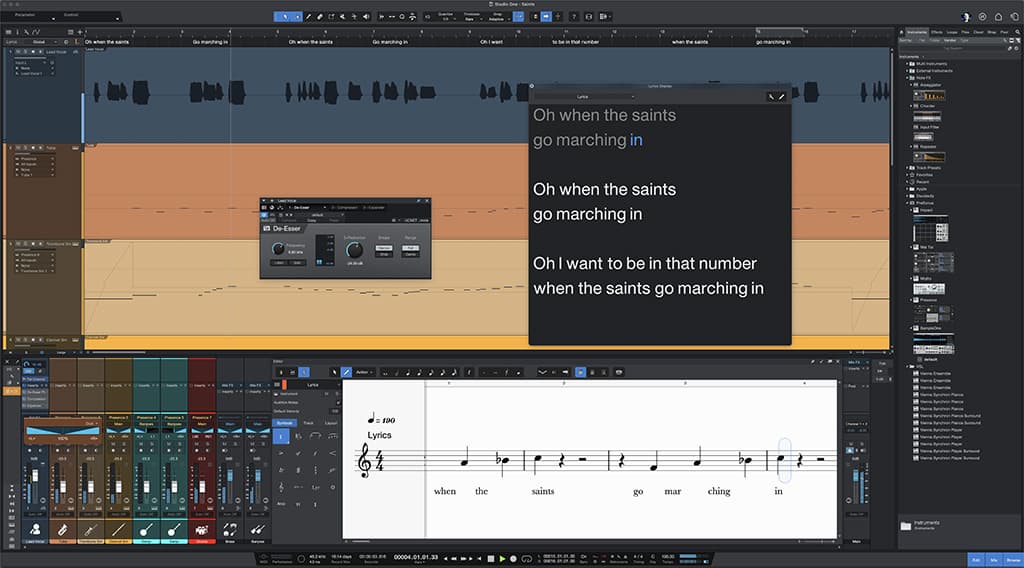
Review: Presonus Studio One V6
Studio One is a genuine contender in the DAW battle, with v6 beefing up its credentials.
Review: Graeme Hague
After the demise of another popular DAW (Cakewalk — Ed.) following its purchase by a well-known guitar manufacturer (Gibson — Ed.), users were worried that a similar fate might be in store for Studio One when PreSonus was acquired by Fender back in 2021 — and with this being the first major update since then these apprehensions seem quite understandable. However, as version 6 actually offers some impressive improvements I can confidently report that the sky didn’t fall, and that the good ship PreSonus is sailing on safely without a penguin in sight — let alone any icebergs.
Gaining popularity with each new version, the release of PreSonus’ Studio One 6 marks some interesting waypoints in the evolution of the DAW. To me, this release represents PreSonus putting its full weight behind Sphere, the subscription model of Studio One. Sphere was launched with v5, but had an underlying sense of PreSonus trying to gauge the reaction of the fanbase to fine-tune how Sphere might actually work. Now Sphere is the flagship of PreSonus’ software range, and with good reason, but more on this later.
With the exception of the rather clever Lyrics Track, the developers of this release have taken the refreshing approach of making innovative improvements to many of the DAW’s existing features, rather than trying to convince users that they’ve re-invented the DAW wheel.
LYRICS & VIDEO
Speaking of the Lyrics Track, this new feature is not merely words on the screen. They can be displayed in a window with a bouncing-ball cue for vocalists to follow, or they can sit linearly within a track, displaying in sync with the song. A text file can be placed in the Global Lyric Track or Melody Track Lyric Lane, and this feature can make locating lyric reference markers in the song a breeze.
Another of the more significant additions in this release is the introduction of Video Track. Studio One has supported video for some time, but this was only ever via a video player interface. Now there’s a dedicated video track that displays progressive thumbnails along the timeline, much like non-linear video editing software such as Sony’s Vegas.
Basic editing functions such as cut, paste, and delete are possible, and you can import as many clips as you like onto the track, but PreSonus is quick to point out that it’s not a full-featured video editor. With that said, users are still able to compose music or place voiceovers that are in sync with video, and can be exported in several popular codecs.
Also of note is the Pro EQ3, which adds dynamic control to the EQ bands. Simply put, you can adjust the EQ bands as per usual, but with a threshold setting on each band to control when the EQ will engage. It’s a bit like a multiband compressor, but in reverse — and it’s going to be everyone’s go-to EQ over a master buss.
NEED TO KNOW
PreSonus Studio One 6
Digital Audio Workstation


I’m sure we’ve all tried to wrangle a daunting de-esser that was difficult to operate, and that we weren’t able to achieve satisfactory results with. Thankfully, there’s a new De-Esser plug-in too. Studio One’s De-Esser is simple to use and gives impressive results — the default settings alone will get you most of the way there.
FLIPPING OUT
Another notable improvement in this release of Studio One 6 is the Fader Flip function in the Mixer section. Think of live digital mixing consoles and their ability to switch through layers on a desk. Similarly, with Studio One, users are able to switch or ‘flip’ the channel faders to control the send levels of any bus or FX channel. This allows for more precise settings, with the longer throw of the faders able to provide smaller incremental values. I also like to use the feature as a fault-finding tool — taking advantage of the fact that Fader Flip provides clear, visual reference to what signal is being sent where. So, if you’re ever having a ‘where the hell is that noise coming from?’ moment, try switching to Fader Flip and it will likely reveal the culprit.
A Customise option now allows users to pare menus down to the essentials. The new Smart Template takes the idea of pre-defining a song further by allowing users to build default layouts, channel configurations, VST instruments included at load-up, you name it.
Studio One comes in several varieties. Studio One Professional is the top-level version and can be bought with a perpetual license. The added functions make it worth the money, with the Project Page being particularly useful, as it provides everything needed to bring a collection of work together to create consistent digital releases. Mind you, the entry-level Studio One Artist is a surprisingly well-featured option for a cost-effective version, and the free Studio One Prime is no slouch — although the inherent limitations of a freebie version may soon become apparent.

Studio One’s future looks bright, devoid of doom and gloom — and no icebergs.
SUBSCRIBING TO CHANGE
This brings us back to PreSonus Sphere, the monthly/yearly subscription version of Studio One. To lure users to the dark-side of the software subscription model, Presonus has included extra plug-ins, and gives users access to extensive loop libraries, cloud storage, and collaborative tools. Of these plugins, the Vintage Compressor, and the EQ emulations of the Fat Channel are my highlights. Another benefit of Sphere’s operation is that the PreSonus server doesn’t need a constant link, so an internet connection is only needed once every 30 days to keep things ship-shape.
PreSonus has worked to create a real sense of community around Sphere, to ensure that it’s more than just a subscription service. With Sphere, users can share ideas and have discussions with other members, work collaboratively on songs, and gain access to expert chat lines and video tutorials.
COMPLETE PICTURE?
So, does Studio One 6 give you absolutely everything you need? With the long list of included VST instruments and plug-ins, and the integration of Melodyne pitch-correction, it’s hard to think of anything that it lacks. The core workflow and GUI of Studio One is quick to get acquainted with, and a lot can be achieved before needing to learn about more complex features. The Studio One community is large and helpful, and PreSonus has produced a huge collection of video tutorials and masterclasses, meaning that help is never far away. By my reckoning, Studio One has become a complete DAW package, with the new Video Track and Lyrics Track ticking the final boxes.
If this is your first foray into DAWs — or even Studio One — then Sphere is a no-brainer. Subscription software is completely stable and reliable these days, and Sphere gives you full access to it all at a minimum of cost. Coming in at US$14.95 per month (US$164.95 per year) it’s on a par with those premium streaming services that we don’t think twice about paying for. There is also a 30-day free trial of Studio One Professional that is ‘coming soon’, if anyone needs to dip their toe in first.
Studio One’s future looks bright, devoid of doom and gloom — and no icebergs.

























RESPONSES